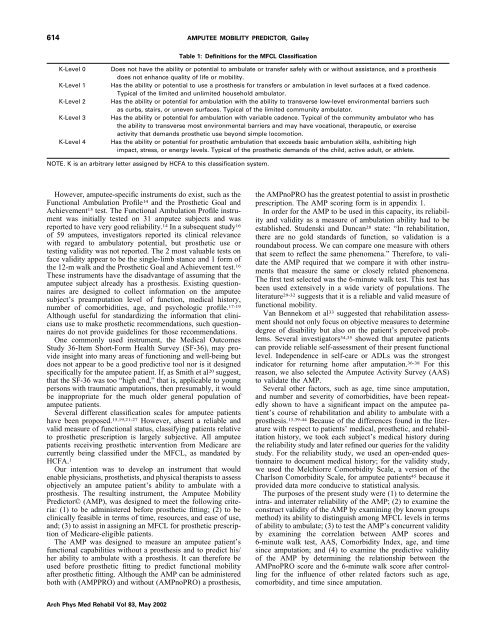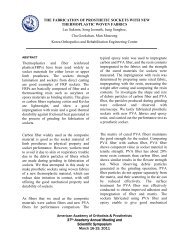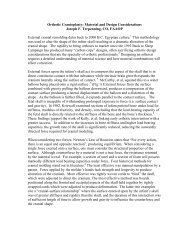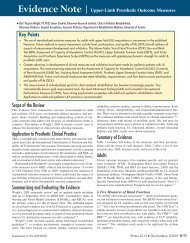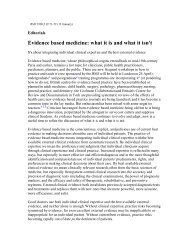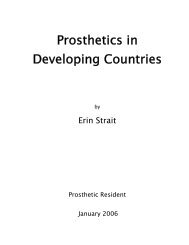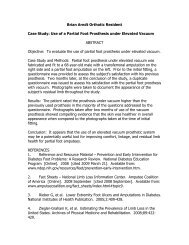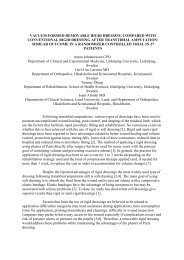The Amputee Mobility Predictor: An Instrument to Assess ...
The Amputee Mobility Predictor: An Instrument to Assess ...
The Amputee Mobility Predictor: An Instrument to Assess ...
Create successful ePaper yourself
Turn your PDF publications into a flip-book with our unique Google optimized e-Paper software.
614 AMPUTEE MOBILITY PREDICTOR, Gailey<br />
However, amputee-specific instruments do exist, such as the<br />
Functional Ambulation Profile 14 and the Prosthetic Goal and<br />
Achievement 15 test. <strong>The</strong> Functional Ambulation Profile instrument<br />
was initially tested on 31 amputee subjects and was<br />
reported <strong>to</strong> have very good reliability. 14 In a subsequent study 16<br />
of 59 amputees, investiga<strong>to</strong>rs reported its clinical relevance<br />
with regard <strong>to</strong> ambula<strong>to</strong>ry potential, but prosthetic use or<br />
testing validity was not reported. <strong>The</strong> 2 most valuable tests on<br />
face validity appear <strong>to</strong> be the single-limb stance and 1 form of<br />
the 12-m walk and the Prosthetic Goal and Achievement test. 16<br />
<strong>The</strong>se instruments have the disadvantage of assuming that the<br />
amputee subject already has a prosthesis. Existing questionnaires<br />
are designed <strong>to</strong> collect information on the amputee<br />
subject’s preamputation level of function, medical his<strong>to</strong>ry,<br />
number of comorbidities, age, and psychologic profile. 17-19<br />
Although useful for standardizing the information that clinicians<br />
use <strong>to</strong> make prosthetic recommendations, such questionnaires<br />
do not provide guidelines for those recommendations.<br />
One commonly used instrument, the Medical Outcomes<br />
Study 36-Item Short-Form Health Survey (SF-36), may provide<br />
insight in<strong>to</strong> many areas of functioning and well-being but<br />
does not appear <strong>to</strong> be a good predictive <strong>to</strong>ol nor is it designed<br />
specifically for the amputee patient. If, as Smith et al 20 suggest,<br />
that the SF-36 was <strong>to</strong>o “high end,” that is, applicable <strong>to</strong> young<br />
persons with traumatic amputations, then presumably, it would<br />
be inappropriate for the much older general population of<br />
amputee patients.<br />
Several different classification scales for amputee patients<br />
have been proposed. 15,19,21-27 However, absent a reliable and<br />
valid measure of functional status, classifying patients relative<br />
<strong>to</strong> prosthetic prescription is largely subjective. All amputee<br />
patients receiving prosthetic intervention from Medicare are<br />
currently being classified under the MFCL, as mandated by<br />
HCFA. 1<br />
Our intention was <strong>to</strong> develop an instrument that would<br />
enable physicians, prosthetists, and physical therapists <strong>to</strong> assess<br />
objectively an amputee patient’s ability <strong>to</strong> ambulate with a<br />
prosthesis. <strong>The</strong> resulting instrument, the <strong>Amputee</strong> <strong>Mobility</strong><br />
<strong>Predic<strong>to</strong>r</strong>© (AMP), was designed <strong>to</strong> meet the following criteria:<br />
(1) <strong>to</strong> be administered before prosthetic fitting; (2) <strong>to</strong> be<br />
clinically feasible in terms of time, resources, and ease of use,<br />
and; (3) <strong>to</strong> assist in assigning an MFCL for prosthetic prescription<br />
of Medicare-eligible patients.<br />
<strong>The</strong> AMP was designed <strong>to</strong> measure an amputee patient’s<br />
functional capabilities without a prosthesis and <strong>to</strong> predict his/<br />
her ability <strong>to</strong> ambulate with a prosthesis. It can therefore be<br />
used before prosthetic fitting <strong>to</strong> predict functional mobility<br />
after prosthetic fitting. Although the AMP can be administered<br />
both with (AMPPRO) and without (AMPnoPRO) a prosthesis,<br />
Table 1: Definitions for the MFCL Classification<br />
K-Level 0 Does not have the ability or potential <strong>to</strong> ambulate or transfer safely with or without assistance, and a prosthesis<br />
does not enhance quality of life or mobility.<br />
K-Level 1 Has the ability or potential <strong>to</strong> use a prosthesis for transfers or ambulation in level surfaces at a fixed cadence.<br />
Typical of the limited and unlimited household ambula<strong>to</strong>r.<br />
K-Level 2 Has the ability or potential for ambulation with the ability <strong>to</strong> transverse low-level environmental barriers such<br />
as curbs, stairs, or uneven surfaces. Typical of the limited community ambula<strong>to</strong>r.<br />
K-Level 3 Has the ability or potential for ambulation with variable cadence. Typical of the community ambula<strong>to</strong>r who has<br />
the ability <strong>to</strong> transverse most environmental barriers and may have vocational, therapeutic, or exercise<br />
activity that demands prosthetic use beyond simple locomotion.<br />
K-Level 4 Has the ability or potential for prosthetic ambulation that exceeds basic ambulation skills, exhibiting high<br />
impact, stress, or energy levels. Typical of the prosthetic demands of the child, active adult, or athlete.<br />
NOTE. K is an arbitrary letter assigned by HCFA <strong>to</strong> this classification system.<br />
Arch Phys Med Rehabil Vol 83, May 2002<br />
the AMPnoPRO has the greatest potential <strong>to</strong> assist in prosthetic<br />
prescription. <strong>The</strong> AMP scoring form is in appendix 1.<br />
In order for the AMP <strong>to</strong> be used in this capacity, its reliability<br />
and validity as a measure of ambulation ability had <strong>to</strong> be<br />
established. Studenski and Duncan 28 state: “In rehabilitation,<br />
there are no gold standards of function, so validation is a<br />
roundabout process. We can compare one measure with others<br />
that seem <strong>to</strong> reflect the same phenomena.” <strong>The</strong>refore, <strong>to</strong> validate<br />
the AMP required that we compare it with other instruments<br />
that measure the same or closely related phenomena.<br />
<strong>The</strong> first test selected was the 6-minute walk test. This test has<br />
been used extensively in a wide variety of populations. <strong>The</strong><br />
literature 29-32 suggests that it is a reliable and valid measure of<br />
functional mobility.<br />
Van Bennekom et al 33 suggested that rehabilitation assessment<br />
should not only focus on objective measures <strong>to</strong> determine<br />
degree of disability but also on the patient’s perceived problems.<br />
Several investiga<strong>to</strong>rs 34,35 showed that amputee patients<br />
can provide reliable self-assessment of their present functional<br />
level. Independence in self-care or ADLs was the strongest<br />
indica<strong>to</strong>r for returning home after amputation. 36-38 For this<br />
reason, we also selected the <strong>Amputee</strong> Activity Survey (AAS)<br />
<strong>to</strong> validate the AMP.<br />
Several other fac<strong>to</strong>rs, such as age, time since amputation,<br />
and number and severity of comorbidities, have been repeatedly<br />
shown <strong>to</strong> have a significant impact on the amputee patient’s<br />
course of rehabilitation and ability <strong>to</strong> ambulate with a<br />
prosthesis. 13,39-44 Because of the differences found in the literature<br />
with respect <strong>to</strong> patients’ medical, prosthetic, and rehabilitation<br />
his<strong>to</strong>ry, we <strong>to</strong>ok each subject’s medical his<strong>to</strong>ry during<br />
the reliability study and later refined our queries for the validity<br />
study. For the reliability study, we used an open-ended questionnaire<br />
<strong>to</strong> document medical his<strong>to</strong>ry; for the validity study,<br />
we used the Melchiorre Comorbidity Scale, a version of the<br />
Charlson Comorbidity Scale, for amputee patients 45 because it<br />
provided data more conducive <strong>to</strong> statistical analysis.<br />
<strong>The</strong> purposes of the present study were (1) <strong>to</strong> determine the<br />
intra- and interrater reliability of the AMP; (2) <strong>to</strong> examine the<br />
construct validity of the AMP by examining (by known groups<br />
method) its ability <strong>to</strong> distinguish among MFCL levels in terms<br />
of ability <strong>to</strong> ambulate; (3) <strong>to</strong> test the AMP’s concurrent validity<br />
by examining the correlation between AMP scores and<br />
6-minute walk test, AAS, Comorbidity Index, age, and time<br />
since amputation; and (4) <strong>to</strong> examine the predictive validity<br />
of the AMP by determining the relationship between the<br />
AMPnoPRO score and the 6-minute walk score after controlling<br />
for the influence of other related fac<strong>to</strong>rs such as age,<br />
comorbidity, and time since amputation.


